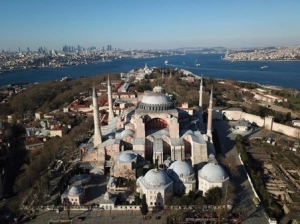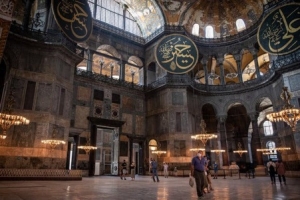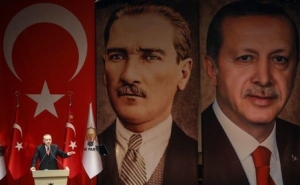mis à jour le Lundi 13 juillet 2020 à 18h01

Turkey’s president wants to convert Hagia Sophia in Istanbul back into a mosque, which threatens to set off an international furor over one of the world’s architectural treasures. Credit...Bulent Kilic/Agence France-Presse — Getty Images

The cathedral, built in the sixth century by the Byzantine emperor Justinian I, stood at the center of Christendom for nearly 1,000 years, until Mehmed II conquered Constantinople and turned Hagia Sophia into a mosque.Credit...Chris Mcgrath/Getty Images

President Recep Tayyip Erdogan of Turkey in front of portraits of himself and Mustafa Kemal Ataturk, the founder of modern Turkey. Mr. Erdogan’s party has dropped in the polls. Credit... Adem Altan/Agence France-Presse — Getty Images
NYT | By Carlotta Gall | Published July 11, 2020
The World Heritage site was once a potent symbol of Christian-Muslim rivalry, and it could become one once more.
ISTANBUL — Since it was built in the sixth century, changing hands from empire to empire, Hagia Sophia has been a Byzantine cathedral, a mosque under the Ottomans and finally a museum, making it one of the world’s most potent symbols of Christian-Muslim rivalry and of Turkey’s more recent devotion to secularism.
Now President Recep Tayyip Erdogan is making moves to declare it a working mosque once more, fulfilling a dream for himself, his supporters and conservative Muslims far beyond Turkey’s shores — but threatening to set off an international furor.
The very idea of changing the monument’s status has escalated tensions with Turkey’s longtime rival, Greece; upset Christians around the world; and set off a chorus of dismay from political and religious leaders as diverse as Secretary of State Mike Pompeo and Patriarch Kirill of the Russian Orthodox Church.
Mr. Erdogan’s opponents say he has raised the issue of restoring Hagia Sophia as a mosque every time he has faced a political crisis, using it to stir supporters in his nationalist and conservative religious base.
But given the severity of the challenges Mr. Erdogan faces after 18 years at the helm of Turkish politics, there may be more reason than ever to take the talk seriously. Having lost Istanbul in local elections last year, the president has watched the standing of his party continue to slide in the polls as the Covid-19 pandemic has further undone a vulnerable economy.
On July 2, a Turkish administrative court ruled on whether to restore Hagia Sophia, or Ayasofya, its Turkish name, as a mosque, and revoke an 80-year-old decree that declared it a museum under Turkey’s secular state. The ruling will be announced within two weeks, and then Mr. Erdogan is expected to make the final decision.
For more than 25 years since he became mayor of Istanbul, Mr. Erdogan has been working to leave his stamp on his beloved home city. He cleaned up the Golden Horn, built bridges and tunnels across the famous waters and placed new mosques at the most prominent sites.
But it is Hagia Sophia, one of the oldest and architecturally one of the most impressive cathedrals in the world, that commands pride of place on the historical peninsula.
Completed in 537 AD, Hagia Sophia stood for nearly a millennium at the heart of the Christian world, crowning the fabled city of Constantinople. It is unsurpassed for its grandeur and immense dome.
In 1453, Mehmed II conquered Constantinople, and although his troops plundered what they could carry, the building was saved and turned into a mosque. For 500 years it was the venerated center of the Muslim Ottoman Empire.
Turks record with pride that Ottoman rulers doted on the great building, assigning the best architects to embellish it. Minarets were added, and later the great Ottoman architect Sinan built massive buttresses to prevent the walls from buckling under the weight of the dome, which was damaged in earthquakes.
With the fall of the Ottoman Empire, the status of Hagia Sophia changed again. Mustafa Kemal Ataturk, founder of the modern secular republic of Turkey, ended the role of religion in the state and closed religious institutions. Byzantine churches, including Hagia Sophia, were made into museums, ending their religious function and opening them up for tourism, conservation and study.
But Mr. Erdogan’s supporters speak of the building as the third holiest site in Islam, after the Grand Mosque of Mecca and Al-Aqsa Mosque in Jerusalem, and insist that once a mosque it should never be unconsecrated.
Mr. Erdogan, who comes from a conservative Muslim tradition, has overseen a steady chipping away of the secular rules of the Ataturk republic, with a concerted effort to revive the glories of the Ottoman era.
At the end of May, he gave his strongest signal yet on Hagia Sophia, as he opened — remotely, because of the coronavirus — a ceremony and sound-and-light show to commemorate the 567th anniversary of the conquest of Constantinople by the Muslim army of Mehmed II the Conqueror.
For the first time in more than 80 years, an imam seated on a carpeted dais before a copy of the Quran recited the verse known as the Conquest surah, which celebrates the Treaty of Hudaibiyah between the people of Mecca and Medina.
The recitation upset many. The Foreign Ministry of Greece, which sees itself as the heir to the Byzantine Empire — which was Greek-speaking and Christian — denounced it as unacceptable and a breach of Hagia Sophia’s status as a world heritage site under UNESCO.
The ecumenical patriarch of Constantinople, Bartholomew, who is the spiritual leader of the Eastern Orthodox Church from his seat in Istanbul, said the conversion of Hagia Sophia into a mosque would disappoint millions of Christians around the world and would divide Muslims and Christians when it had been a place of worship for both.
“We consider it as detrimental,” he said in a sermon last week, “for Hagia Sophia, which, due to its dedication to the Wisdom of God is a point of encounter and a source of fascination for the faithful of both religions, to become, in the 21st century, a cause of confrontation and conflict.”
He urged the Turks to honor what he described as their obligation to the world. “The Turkish people have the great responsibility and the highest honor to give prominence to the universality of this exquisite monument,” he said.
Mr. Pompeo urged Turkey before the court hearing to respect the diverse traditions and faiths of Turkey’s history and keep Hagia Sophia as a museum accessible to all.
Many in Turkey see the entire debate as a political ploy by Mr. Erdogan to remain ahead of his many rivals, especially as former members of his Justice and Development Party have broken away to form their own political parties and threaten to draw away some of his conservative Muslim base.
He has made it a nationalist issue, lashing out at Greece for interfering in his country’s affairs and insisting that Turkey was proceeding according to the law.
“Is it you managing Turkey or us?” he said. “Turkey has its own institutions.”
His nationalist coalition ally Devlet Bahceli weighed in with a speech on the same day: “Hagia Sophia is the conquest Mosque of the Muslim Turkish nation. This truth will not change.”
“This shows that there is something catching fire, something burning in the dynamics of this country,” Mr. Erdogan added.
Even a former member of Mr. Erdogan’s cabinet, Ertugrul Gunay, who served as minister of culture for five years, said Mr. Erdogan was making a fanfare over Hagia Sophia only to show he was still master of Istanbul after his electoral loss.
“The need to be more visible in Istanbul and to claim ownership of certain rituals about history and religion emerged,” he said in a television interview.
“There are multitudes of grand mosques spread throughout Istanbul,” he added in a text message. “This discussion of Hagia Sophia to be converted to a mosque done by the conservatives of Turkey is an old and unnecessary discussion.”
Beyond politics, art historians and conservationists worry that they will lose access for study and research if the monument becomes a working mosque, and tourist companies and city authorities fear that visitors will be deterred from coming. The monument is the most visited tourist site in Turkey, with 3.7 million visitors last year.
“I am more interested in preserving Hagia Sophia as a cultural treasure,” said Zeynep Ahunbay, a conservation architect who has worked on the scientific committee for Hagia Sophia for 25 years. “The best way to preserve and present it is by the museum function.”
The greatest worry is what will happen to the incomparable medieval mosaics, among them depictions of Christ, the Virgin Mary and John the Baptist, alongside rare portraits of imperial figures including Emperor Justinian I and Empress Zoe, one of the few women to rule in her own right.
The mosaics were whitewashed for the more than five centuries during Ottoman rule — the depiction of the human form being considered idolatry — and were uncovered and restored only after Hagia Sophia was turned into a museum in the 1930s.
“We don’t know what will happen to the mosaics and frescos,” said Faruk Pekin, founder of Fest Travel, which specializes in cultural tours and led 80 nighttime tours of Hagia Sophia last year.
One of the delights of touring the building at night, he said, was that the dome seems even larger and the gold mosaics gleam more brilliantly in the dim light. Visitors pay double for the nighttime tour, and most of his customers are Turkish, he said.
If the museum becomes a mosque, the mosaics will have to be covered during Muslim prayers somehow, including seraphs high up at the base of the dome. Tourists and non-Muslims may be restricted to certain areas, he said.
“I still hope it will not happen.”


